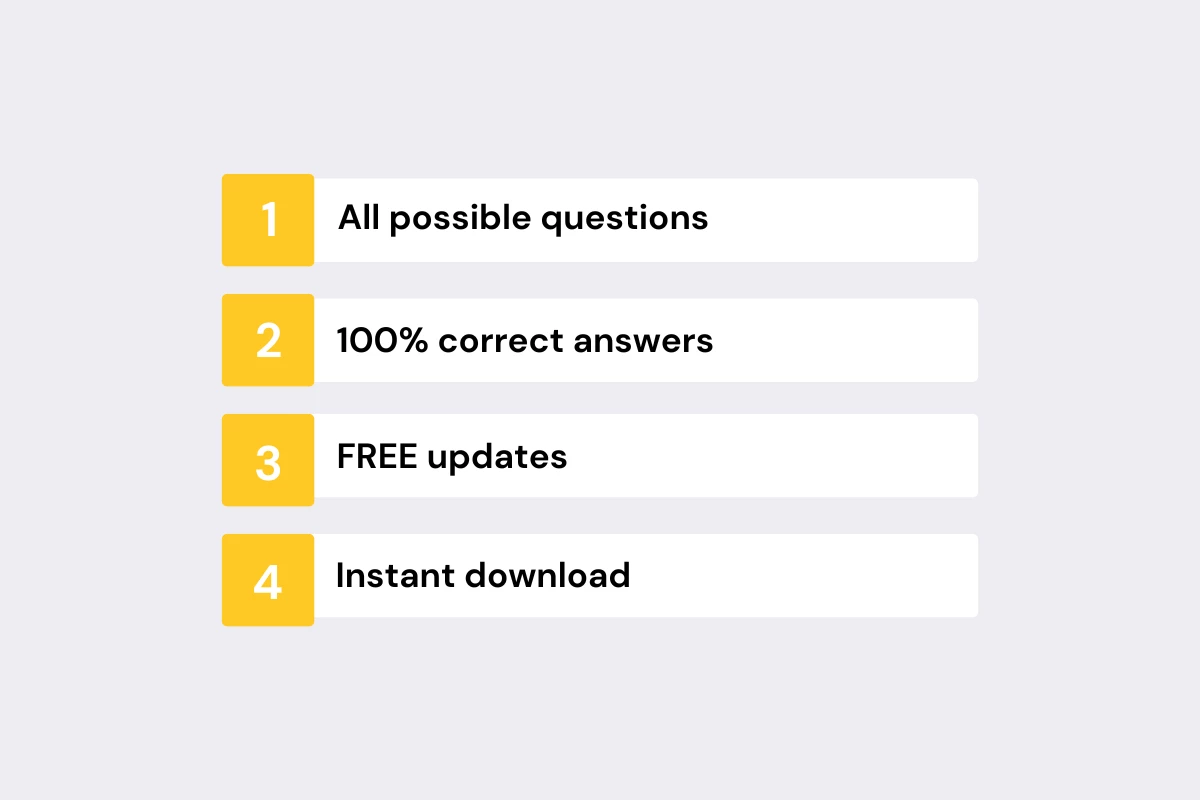This file contains all possible real exam questions with 100% correct and verified answers. Free updates included. Save your time.
Below you’ll find some selected questions from the latest real certification exam. You can get an idea about the exam format and prepare for it smarter. Need all exam questions with answers? Consider downloading our file.
What are the benefits of using Data Studio?
- Allows you to visualize your own data
- Free of charge
- Accessible on web-connected devices
- Access to additional attribution models
Which are examples of data sets?
- Google-generated data, such as Google Analytics or Google Sheets
- A data source based on a CSV file
- Metrics and dimensions typed directly into Data Studio
- Amazon sales data
Once you’ve connected your data in Data Studio, how often do you need to manually provide your data set credentials again?
- Every time you load the report
- Monthly
- Annually
- Only if you’ve revoked access
Which types of components can be included in a report?
- Text
- Images
- Charts
- Templates
Which term refers to the underlying data that can be connected to Data Studio?
- Data set
- Data source
- Data control
- Data connection
Which access permission would you provide to a coworker to collaborate with them on a report?
- Can view report
- Can edit report
- Can view data source
- Can edit data source
To share your report via a public link and allow all viewers to see chart data, which data source setting would you choose?
- Invite user to view
- Invite user to edit
- Use owner’s credentials
- Use viewer’s credentials
What is the order in which data flows into Data Studio charts?
- Data set → data source → report → chart
- Data source → data set → report → chart
- Component → data source → report → chart
- Data set → report → data source → chart
If you upload data from a CSV file to create a data set in Google Cloud, how can you update that data set in the future?
- Upload a CSV file with only the new rows of data
- Upload a CSV file with all the original data and additional data
- Click the refresh fields icon in the data source to automatically upload changes from the file on your computer
- Manually edit the data in the Data Studio report
Which feature helps you create a new report quickly?
- Owner’s credentials
- Edit access
- Templates
- Controls
Passing exams is not a workout. Multiple attempts won’t make you stronger.
Save your time with our answer-sheets. Get certified in minutes.
Which actions can you take on the Data Studio Home page?
- Create a new report
- Share a report with others
- Edit data source fields
- Connect to data
Which is the best tool to quickly visualize data that answers a specific question without saving or sharing it?
- Data source
- Explorer
- Report Gallery
- Templates
What can you do with the Explorer tool?
- Invite others to view or edit your explorations
- Export an exploration as a chart into a new or existing report
- Toggle between view and edit modes
- Automatically save all changes to explorations
What can you do with calculated fields?
- Create a metric or dimension using a mathematical formula
- Change an existing field’s aggregation
- Transform tables into pie charts
- Disable fields from the data source
What can an individual viewing a report do?
- Hover over charts to see specific data point information
- Filter data
- Select a date range
- Make a page-level component report-level
What is the benefit of using the Theme tab?
- The ability to adjust a report’s canvas size, grid settings, and page navigation position
- The ability to set consistent font and color selections for all components
- The ability to use templates for quick report building
- The ability to enable field editing in reports
Which components must get their data from a data source?
- Images
- Bar charts
- Scorecards
- Embedded content
In which ways can you change an existing field?
- Display the count of unique field values
- Change the format of a date field
- Display the output of a custom mathematical formula using the field
- Change the name
What must the data source owner do to allow report editors to modify data fields?
- Enable field editing in reports
- Use owner’s credentials
- Give edit access to the data source
- Prevent editors from changing access and adding new people
Which setting makes your report larger?
- Style tab
- Canvas size
- Report theme
- Grid settings
What is the purpose of extracting data?
- Create robust data sources with over 100MB of data
- Maintain a live connection between your data set and data source
- Use connectors not available through Google or partners
- Use a subset of your original data for faster report performance
What does the “refresh fields” button in the data source do?
- Update stale data in your report’s charts
- Reflect changes made to the data set’s schema
- Save changes you make to the data source fields
- Saves updates made to data source field names
What is unique about a report-level component, compared to a page-level component?
- Report-level components appear in the same position on each page
- Report-level components are the default component type
- Report-level components can reference multiple data sources at once
- Report-level components have interactive properties for viewers to filter data
What is one benefit of using blended data?
- The ability to combine data from different time periods in one chart
- The ability to visualize data from multiple data sources in one chart
- The ability to join multiple data sources without any common dimensions
- The ability to share combined data sources between reports
What does a filter control allow viewers to do?
- Select a different data source to visualize
- Filter report data based on one or more dimension values
- Change the date range of a report
- Import their own data into your report template
What do the Theme tab settings affect?
- All reports in your account
- All components in the open report
- All components in the open page
- The selected component only
What can a single filter control affect?
- Charts
- Scorecards
- Groups of components
- Multiple dimensions
What is required for a single chart to reference data from two different data sources?
- Attach both data sources to the report
- Select the appropriate dimensions from the chart data tab
- Create a blended data source
- Add a data control to the report
Which sharing option always requires recipients to log in with their Google account?
- Shareable link
- Invitation to edit
- PDF download
- Viewer’s credentials
What is the purpose of creating a thumbnail image of your report?
- Invite others to view your report’s first page and hover for more detail
- Give users with view or edit access a preview of your report before opening
- Allow users to quickly download a non-interactive copy of your report
- Download a full-size PDF for offline viewing
Which reflects a best practice for designing your report?
- Use only one report per page, including much text annotation to summarize findings
- Use the first page as a high-level overview, and add additional pages as needed for more detail
- Use contrasting colors for each different chart
- Use pie charts to compare 10+ segments of a whole
How can you use any Data Studio report as a template?
- Copy the report as new and select your data source(s)
- Copy the data source and select your data set(s)
- Use templates available on the Data Studio Home page
- Ask the report owner to enable viewer’s credentials
What is the purpose of a bullet chart?
- Show the total for a single metric
- See how well a metric is performing against a target
- Identify a correlation between data points
- Highlight a single, critical metric
What is the purpose of templates?
- Quickstart data source creation
- Quickstart report creation
- Offer design tips based on connector
- Extract data for improved report load time
What is the purpose of a scatter plot?
- Observe trends over time
- Track performance against a target
- Identify a relationship between variables
- Compare multiple parts of a whole





